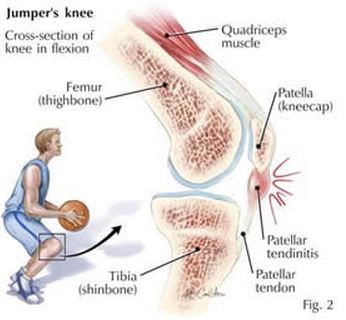Jumpers knee or patellar tendonitis is pain in the tendon which attaches the kneecap or patella to the top of the shin bone or tibia. It is usually an overuse injury caused by repetitive strain.
Patellar tendonitis can be a tricky condition to treat and requires a substantial period of rest and a thorough treatment and rehabilitation program. In the most severe or persistent cases, surgery may be required.
Symptoms of jumpers knee consist of pain at the bottom front of the kneecap over what is called the lower pole of the patella.
The bottom of the patella will be very tender when pressing in. The athlete is likely to experience aching and stiffness after exercise and pain when contracting the quadriceps muscles in acute cases.
The affected tendon may appear larger than the unaffected side. In particular jumping activities are likely to be most painful. See jumpers knee assessment for more details. Jumpers knee can be categorised into four grades of injury:
Warning!! – This injury may seem like a niggling injury that is not that bad. Many athletes continue to train and compete on it as it may not be a debilitating injury and recovers after a short period of rest. However, neglect jumpers knee at your peril! If left to become chronic it can be very difficult to treat and may require surgery.
The patella tendon, also known as the patella ligament joins the kneecap or patella to the shin bone or tibia. The patella tendon is extremely strong and allows the quadriceps muscle group to straighten the leg. The quadriceps actively straighten the knee in jumping to propel the individual off the ground as well as functioning in stabilizing their landing. Huge forces are transferred through the tendon.
As such this tendon comes under a large amount of stress especially in individuals who actively put extra strain on the knee joint such as those who regularly perform sports that involve direction changing and jumping movements. With repeated strain, micro-tears as well as collagen degeneration may occur as a result in the tendon.
This is known as patellar tendinopathy or Jumpers Knee. It should be distinguished from patella tendonitis (tendinitis) as this condition indicates an acute inflammation of the tendon whereas tendinopathy is more about degeneration of the tendon. In practice the majority of chronic cases are more likely to be degeneration of the tendon rather than acute inflammation which should settle down after a few days rest.
It is likely that an athlete with patella tendonitis will have poor Vastus medialis obliquus (VMO) function. This is the muscle on the inside of the quadriceps near the knee. They may also have significant weakness in the calf muscles.
What can the athlete do?
Jumpers knee treatment the athlete can do themselves depends on the extent or grade of the injury. A more severe injury may require longer rest and may result in surgery. Rest from training In mild to moderate cases, adaptation of training to reduce impact and jumping activities may be suitable.
Apply cold therapy on a regular basis, especially during the acute stage which is usually the first 24 to 48 hours and after any form of exercise. If the tendon is painful then ice can be applied for 10 minutes every hour reducing frequency as symptoms improve.
Wearing a knee support, or jumpers knee strap can reduce pain and ease the strain on the tendon. A jumpers knee strap wraps around the tendon just below the knee changing the angle of the tendon against the patella which changes the part of the tendon the forces are transmitted.
Stretch the the quadriceps muscles regularly and see a sports injury professional who can advice on treatment and an eccentric exercise rehabilitation program.
What can a Sports Injury Professional do?
See full story on sportsinjuryclinic.net
Image courtesy of sportsinjuryclinic.net


